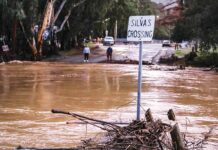Just 15 miles separate Hollister and Gilroy, but farmers in the
adjacent towns have been affected by the state’s current drought in
entirely different ways.
Just 15 miles separate Hollister and Gilroy, but farmers in the adjacent towns have been affected by the state’s current drought in entirely different ways.
California is struggling with a complex situation that includes protection of the threatened Delta smelt species, water rationing, proposed bond measures, the lowest level of spring rainfall on record, fields left fallow by local farmers – while proposed state legislation would bring a bond before voters to generate almost $10 billion toward fixing the problems.
In San Benito County, sharp reductions in “blue valve” water due to the 2-inch-long Delta smelt’s problematic habitat have caused significant impacts. Water district representatives say the system provides water to about 400 farms here of 10 acres or more.
“I’ve used up my allotment on the blue valves,” said Al Bonturi, a local walnut grower. He was referring to heavily used, state-provided, supplemental water that arrives in pipes with cobalt blue valves.
“They put a chain and a lock on the valves and that was that,” Bonturi added.
Bonturi said he now relies on his own pump and well, which he has kept in good condition despite not using it for years.
But many Hollister farmers have had their wells collapse or otherwise become inoperable since the state began allocating blue valve water. Those growers now must get on lengthy waiting lists to have expensive repairs done or new wells drilled.
“When blue valve water came in,” continued Bonturi, “it was a Godsend because some people had no water at all. Before cutbacks, they gave you between 1.5 and two acre-feet of water per acre. They cut that back 45 percent.”
Richard Bianchi, a Hollister farmer and a director of the San Benito County Farm Bureau, knows this problem intimately.
“I have one well that cost $170,000 to bring back on,” said Bianchi. “The water quality from blue valve was so much better that a lot of people let the wells go.”
Gilroy stands in stark contrast to the Hollister crises due to the fact that most farmers have never used blue valve water because it has not been necessary.
Nearby farmers are miles apart in the way water is distributed
“We have good wells in Gilroy, and water is available from the San Luis Dam from the canal that was built into this area,” said Chuck Buckley of Buckley u-Pick Cherry Farms, “It would take several years of drought to affect the wells on my property.”
He also pointed out how he hadn’t talked with any Gilroy farmer who expressed great concern about water.
Greg Van Wassenhove, agricultural commissioner for Santa Clara County, echoed that sentiment.
“I am not aware of any farmers that are feeling like they are in trouble.”
Van Wassenhove said both San Benito and Santa Clara counties had their request for disaster status due to the drought approved in Sacramento, clearing the way for low interest loans.
Another reason growers in Gilroy have been less affected by the drought is that there are 10 reservoirs in Santa Clara County, said Susan Siravo, spokeswoman for the Santa Clara County Water District.
“Our ag people are just not as reliant on outside water as farmers in other counties,” she said.
The agricultural commissioner in San Benito County, meanwhile, tells a much different story.
“I see many fallow fields due to the water situation,” said Paul Matulich, the farming official in Hollister. “I see farmers having to pick and choose what they grow, I see the ones that used to put in three crops a year … just putting in two.”
State leaders stepping in
In the midst of California’s drought, Assemblywoman Anna Caballero, (D-Salinas), has co-sponsored a $9.8 billion bond measure designed to “repair and sustain the complex ecosystem of the Sacramento-San Joaquin Delta, and provide early relief to communities around the state affected by drought, contaminated drinking water, and the need for secure water supplies.”
Caballero noted how the San Luis Reservoir, which supplies water to both counties, is at 13 percent of capacity.
Caballero is involved with the bill that was designed to reflect a proposal introduced by Gov. Arnold Schwarzenegger and U.S. Sen. Diane Feinstein three weeks ago. That proposal urged lawmakers to come up with a feasible bond and provided a framework of suggestions for the state Assembly.
Although the bond does not specify funds for new dams – which local farmers and both agricultural commissioners insist is necessary in California – it would set aside $3 billion for “public benefit” projects to enhance the sustainability and provide improvements to the Delta.
“That bill would be $10 billion well spent,” said Matulich in San Benito County. “The population of California has shot up, but we haven’t been building more dams to keep up.”
To avoid a continuous series of crises caused by drought and government regulation in California, action must bet taken, said Danny Merkley, director of water resources for the California Farm Bureau.
“Without reliable and affordable sources of water, farm production starts to shrivel,” he said. “That leads to lost markets, and lost markets lead to lost jobs. It’s a terrible cycle that we must break by fixing California’s water system and assuring reliable supplies for everyone.”
Included in the state proposal:
-$500 million for drought relief.
-$1.5 billion for water supply and reliability projects.
-$1.9 billion for projects to revitalize the Delta ecosystem, and provide environmentally sustainable water supply.
-$1 billion for enhanced management and protection of watersheds in regions throughout the state.
-$360 million for groundwater protection and cleanup.
-$500 million for water recycling and reuse, and for desalination projects
-More than $300 million specifically for projects to aid economically disadvantaged communities.
Source: Assemblywoman Anna Caballero’s office















